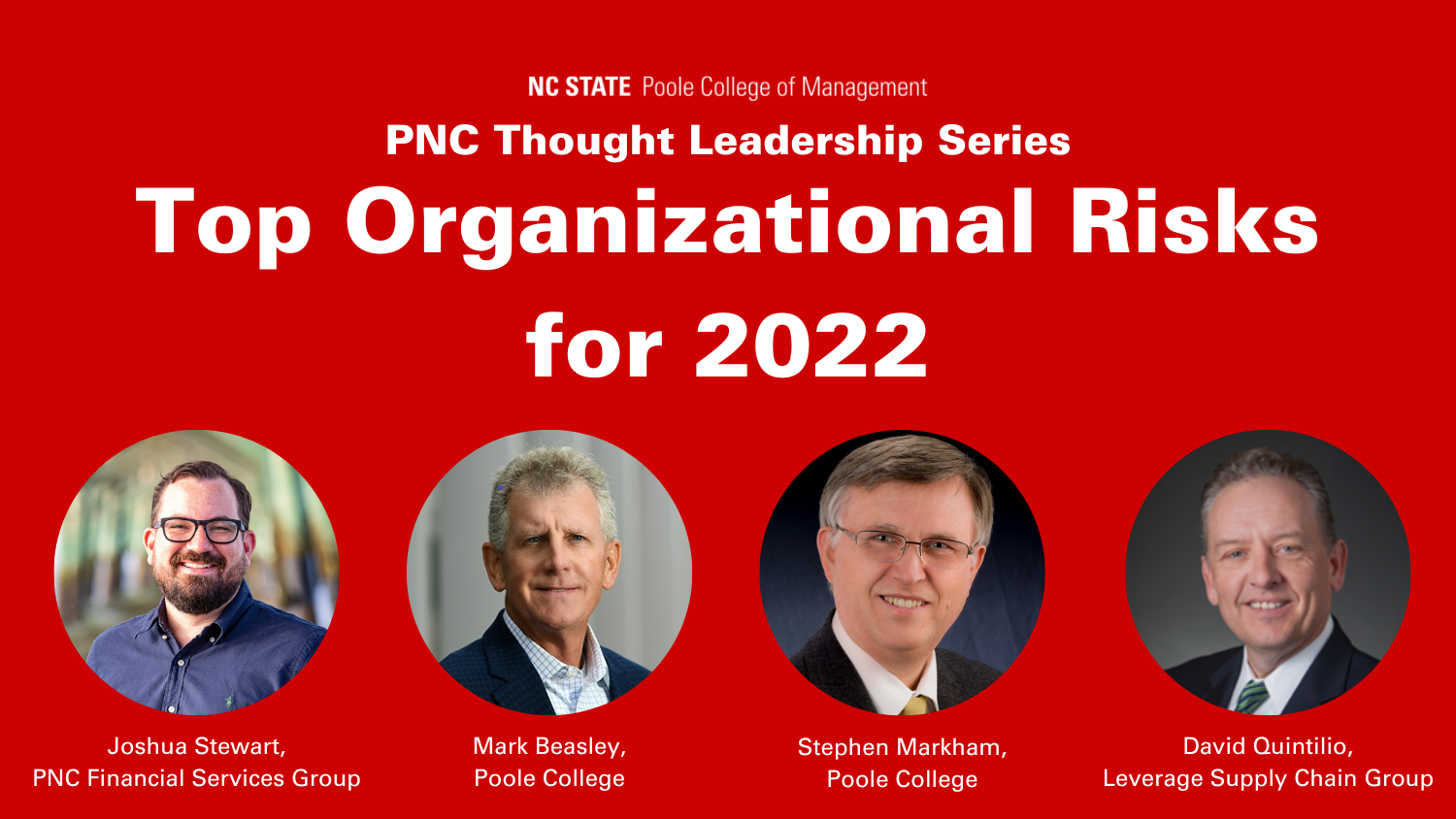NC State Poole College of Management hosted the spring edition of the biannual PNC Thought Leadership Series on April 13. The event tackled the top risks facing global executives, as reported in the 10th annual survey by Protiviti and the NC State ERM Initiative. The conversation focused on current and future organizational risks, lessons learned from the COVID-19 pandemic, key strategies for the future of the business industry and advice for the next generation of corporate leaders.
Mark Beasley, Poole College professor of accounting, led the discussion with a panel of experts, including:
David Quintilio, President, Leverage Supply Chain Group
As the founder of Leverage Supply Chain Group LLC, Quintilio works with global companies to improve their existing logistics network and accelerate their supply chain flows. Prior to starting his management and consulting services business, Quintilio spent 36 years in the supply chain and logistics side of UPS until retiring in 2021. His most recent role at UPS was senior vice president of global operations for UPS Healthcare.
Earlier roles included a variety of positions with increased responsibilities in both operational and functional capacities. In 1999, Quintilio accepted a corporate controller position. He transitioned to the UPS supply chain business in 2004 and during this tenure served an international assignment, based in Toronto, as country controller.
Stephen Markham, Professor of Technology Management, Poole College
Stephen K. Markham is a professor of management, innovation and entrepreneurship at Poole College. He teaches technology entrepreneurship, corporate innovation, product and portfolio management, strategy and analytics. Markham’s research on champions of innovation and product development is widely cited. He served on the editorial board of the Journal of Product Innovation Management and as president of the Product Development and Management Association’s Research Institute where he conducted industry-wide research on best practices in product development and the front-end of innovation. At NC State, he was the director of the Center for Innovation Management Studies and the Technology Entrepreneurship and Commercialization program.
Markham specializes in bringing new technologies from lab to market. He served as the senior vice president of global strategy and portfolio for Toshiba’s global commerce solutions division where he redesigned the portfolio management system, revitalized the portfolio and integrated the global printing business. He co-founded several technology startup companies including LipoScience, LipInc, HueMetrics and Kyma Technologies.
Joshua Stewart, Senior Vice President and Head of Talent Acquisition, PNC Financial Services Group
Joshua Stewart is senior vice president and head of talent acquisition at PNC. A PNC employee for 19 years, Stewart maintains oversight of talent acquisition, sourcing, employment marketing, early career internships/development programs and accessibility.
Previously the director of talent solutions and outreach, he also maintained oversight of PNC’s K-12 recruitment strategies, including the 2018 launch of the PartnerUp program. PartnerUp is a PNC-led, multi-employer collaborative that develops and recruits career-bound high school seniors from underserved school districts. An ardent advocate for diversity, equity and inclusion, Stewart served as the founding president of PNC Proud, the Lesbian, Gay, Bisexual, Transgender, Queer (LGBTQ+) employee business resource group. He is a co-author of the Forté Foundation’s Men As Allies toolkit training program, leads PNC’s Men As Allies program and provides coaching to organizations facilitating the program around the globe.
Below are some highlights.*
*Please note some of the responses were condensed for clarity and brevity.
What are the big-ticket risk management lessons that you’ve observed from the last two years?
Stewart: It’s been a wild ride for everyone. Human resources showed its value in ways that we couldn’t have imagined. For talent acquisition, we had to figure out how to interview virtually and determine the equity and fairness of the virtual interview process. Looking back, a lot of the new processes are better than what we used to have … so what do we keep? What should go back to the way it was before?
Quintilio: Overall, capacity and planning for major ebbs and flows were the big lessons. Many clients couldn’t get product, while others had plane loads of product and didn’t have a place to put it. And the same went for employees, [who said,] “We can’t get people; how can you help us?” So, being prepared for those ebbs and flows is one of the big lessons learned. But it’s somewhat like a 100-year flood. How much can you plan for? Are you going to prepare for that epic state? At the very least, organizations should have enterprise risk programs that lay a blueprint for what to do, and that’s what was lacking. People had plans but didn’t include all of the supply chain partners. You have to have a “we” program, and not just the false confidence of one within your own organization.
Markham: Budget uncertainty was a huge problem. Knowing what we can do and what we can’t do within the next few months or year was really the hardest part.
What advice would you give the next generation of young professionals to prepare them for an epic event like the pandemic?
Markham: You have to keep moving forward and trust in relationships.
Stewart: Those who were agile and thinking innovatively to develop new solutions are the ones that are prevailing now.
Quintilio: Quick decision making is what sets apart those who got through the pandemic better than those who didn’t. People who made moves first did better – you just can’t be afraid to make those big decisions during a crisis like this.
Based on the trending risks for 2022 and beyond, what should executives be thinking about over the next 12 months?
Quintilio: Labor… The Great Resignation is hitting the vice president, director and front-line levels. Right now, service industries are fighting for the same pool of people. It brings up the question of implementing new technologies – robots and artificial intelligence (AI) – that are amazing and work so well from an efficiency standpoint. But there’s also a risk. Just think about the risk of cyber-attacks when an entire supply is predicated on AI and robotics. We don’t even know those risks right now.
Stewart: Talent, in the short and long term – although in the very short-term, it is developing a pipeline of candidates to fill available positions right now.
Markham: Inflation will drive a lot of decision making. It’s going to affect both talent and supply chain – and every other organizational decision for years to come.
“Talent” dominated the top 10 risks list. What are the biggest talent-related issues organizations should plan for in 2022?
Stewart: The No. 1 thing we’re focused on is finding operational efficiencies and changing the recruiting process. One way we’re doing that is with panel interviews – getting everyone together in a room to talk about candidates. It’s been a wonderful thing for diversity and inclusion and for collaboration across teams and lines of business. We’re also being intentional about recruiting outside of the four-year degree pool. Building the pipeline from high school to banking is a huge priority for PNC.
In the coming months, we’ll also continue focusing on maintaining workplace culture and providing learning and development for employees working remotely and in-office. And lastly, we’ll continue to make diversity, equity and inclusion (DE&I) a priority. There has been progress, but more work remains. It’s an emerging opportunity to double down and rethink DE&I and embrace the diversity in the talent pool.
“Supply chain” is also high on the risks list. How would you coach business leaders as they think about supply chain for 2022 and beyond?
Quintilio: Look at labor, look at capacity and build in flexibility. It starts with going all the way upstream and working down from there. Look at how much of your supply chain is single-threaded and work to make it multi-threaded. You don’t know what will dam up the supply chain upstream… and at the same time, you need to be prepared for when the dam breaks and how you can work around it. This is where we bring in innovation, technology platforms and analytics. These events are happening in real time, so having visibility all the way upstream by creating agility in the supply chain will be key in finding balance and planning.
Markham: As we go forward, we have to think about respecifying product requirements based on customer needs. Businesses need to offer substitute products and partner with new vendors. Customer expectations are changing, and if we try to retrench what we did in the past, we’re going to frustrate ourselves and our customers. There’s a window open to rethink business models and products.
Imagine it’s 2032, what are the issues you think will be on an executive’s radar?
Markham: I think we’re going to transition back to normal at some point. The transition point will come when managers say, “We’ve got to get back to business,” and the pandemic can’t be used as an excuse. When that happens, people with good plans who keep moving forward are going to be fine; other people are going to be looking for jobs. So, understanding that there’s going to be a transition from this exception that we are in right now is going to be important. Inflation is going to continue to impact decision making and it will likely take about three years to work through that. How we go forward is a matter of will, not skill. You have to have the mindset of ‘We’re going to do this and we’re going to make it work,’ and you’ll pick up the skills along the way.
Quintilio: The importance of supply chains in the boardrooms and key decision-making positions has been heightened, and that will continue to be a theme because we saw how much it impacted businesses globally. When the water is calm, plan for that title wave – that really sums up the theme of what we are seeing.
Stewart: Talent isn’t going away. In 10 years, we’ll see a different recruiting landscape, but the labor challenges won’t go away. We also have to continue to chip away at DE&I. What will that look like in 10 years? And what work are we doing now to stay ahead of it? So, when it comes to talent, we must evolve and disrupt talent practices and processes.
- Categories:
- Series:



